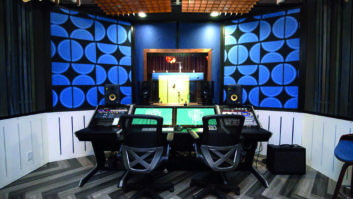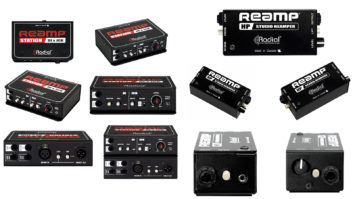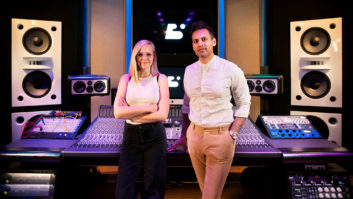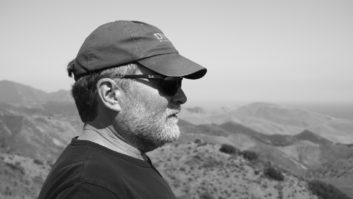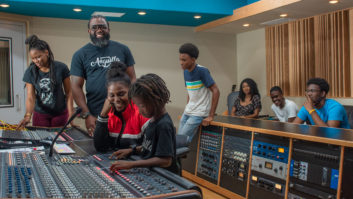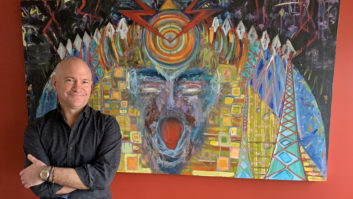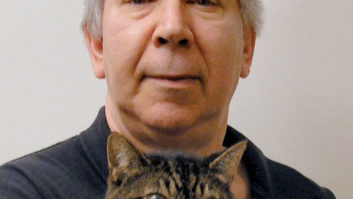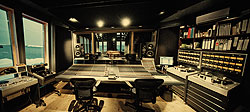
Each June, we canvas the studio scene to find the hottest new facilities to open in the past year. This year’s survey brought in more than 50 great rooms, making for some very tough decisions. Here, then, are the top 20 studios to come online since June 2010. For a look at all submissions and more detailed descriptions, go to mixonline.com for an extended photo gallery.
Photo: Fredjonny
Ocean Sound Recordings
(Giske, Norway)
Date Opened: February 2011
Designer:/Acoustician: Ric Vaughan Audio Designs
Console: Neve VR60 with Flying Faders
Monitors: Dynaudio M3s with Chord SPA 1032 mono blocks, ProAc Studio 100
At-a-Glance: “The design criteria was to build an ambient room with controllable acoustics,” says Vaughan. “The control room is an even natural space so there is good imaging frequency response, no matter where you sit.”

Photo: Lou Johnson
Red Door Studio
(Murfreesboro, Tenn.)
Date Opened: January 2011
Designer: studio bau:ton
Acoustician: Carl Tatz Design
Console: Yamaha DM2000
Monitors: CTD Dual PhantomFocus System: pair of custom TEC:ton Engineering mains with double 15-inch TAD woofers and Sony compression drivers; multiple Bryston 7B amps; Event Opal near-fields
At-a-Glance: Middle Tennessee State University professor and Grammy-winning producer/engineer John Merchant’s new space houses a large control room where he will teach advanced master classes. Other features include massive bass trappings in walls and soffits, diffusive stone-front monitor wall and louvered monitor ceiling.

Photo: Diana Lynn Ring, DiLynnRing.com
Media Right Productions
(New York City)
Date Opened: January 2011
Designer/Acoustician:: Joe Salvatto
Consoles: Vintage Neve discrete 40-channel console featuring 33114s (40), Euphonix System 5
Monitors: Barefoot
At-a-Glance: This new 15,000-square-foot studio environment was built for composer/producer Doug Maxwell and a select clientele. It also serves as a teaching facility where Visionary Media, a charity founded by Maxwell, trains and employs blind musicians and audio professionals.

Photo: Amanda Myers
Stonewall Studio
(Cantonment, Fla.)
Date Opened: January 2011
Designer/Acoustician: Jeff Hedback
Console: Euphonix MC Mix, MC Control (3)
Monitors: Blue Sky System One 2.1
At-a-Glance: This private-use facility features a control room that uses hallway spaces and membrane characteristics of wallboard systems to balance isolation and an accurate LF response. Shown: live room.

Photo: James F. Wilson
Wire Road Studios (Houston)
Date Opened: March 2011
Designer/Acoustician: Russ Berger Design Group
Consoles: Euphonix DSP S5 Fusion 40-fader, Avid C|24
Monitors: ATC SCM200ASL, SCM150ASL, SCM0.1/15 Pro, SCM25A Pros; Focal Twin6 Be near-fields
At-a-Glance: This 5,000-square-foot, ground-up, two-story facility features Control Rooms A and B that share a central machine room. Studio C on the second floor serves as a video-editing studio. Control A looks onto a live room with 18-foot ceilings and two iso booths. Control B has a production iso booth.

Photo: Steven Klein
audiomachine (Burbank, Calif.)
Date Opened: January 2010
Designer/Acoustician: Steven Klein’s Sound Control Room
Console: 32-channel Rupert Neve Designs
Monitors: Barefoot MM27
At-a-Glance: Private facility for composer/producer/ owner Paul Dinletir. Composer’s workstation is also the primary mix position in all of the rooms. “Critical monitoring at all volume levels with room for guests and the ability to conduct meetings were the fundamental control room requirements,” says Klein. “I designed the front part for proper ratios and widened the rear of the room. The result is an accurate control room with a spacious living room feel. Adding to the comfort of the back of the room is the absence of boundary walls and bottom-end anomalies that normally occur in a more traditional design.”

Photo: LP Swist
Eastman East Wing Media Production
Suite (Part of Eastman School of Music;
University of Rochester, N.Y.)
Date Opened: December 2010
Designer/coustician:: Lawrence P. Swist Designs
Console: Euphonix System 5
Monitors: Guzauski-Swist GS-3a 5.1 monitor system
At-a-Glance: “This new 5.1 control room was designed as the audio hub [connection via MADI] for all the major venues within the Eastman facility,” says Swist. “Accurate monitoring capabilities were paramount in the design because of the amount of live multichannel mixdown required for distance learning sessions, Internet distribution, live broadcast and/or general archiving purposes.”

Photo: John Rodd and Andrew Nikkel
Clearstory Sound (Los Angeles)
Date Opened: April 2010
Designer/Acoustician: Peter Grueneisen, nonzeroarchitecture
Controller: Pro Tools HD Accel
Monitors: ATC SCM 150 ASL active (L/C/R) [not pictured; purchased May 2011], Dynaudio BM15 passive and PSB Stratus Gold mid-fields, numerous near-fields
At-a-Glance: Private recording/mixing/mastering space for engineer John Rodd incorporates numerous windows to give an airy feel. “I spend a lot of time in dark recording studios,” says Rodd, “so when I was able to build my own studio from the ground up, I made sure it had a lot of natural diffuse sunlight.” The studio has hidden Helmholtz resonators, membrane-faced bass traps and effective soundproofing throughout. The ceiling joists, hidden diffusors and high-performance/full-spectrum acoustic absorption all work to create effective diffusion and absorption.

Photo: Hanson Hsu
Laser Pacific Theater 3 (Hollywood)
Date Opened: February 2011
Designer/Acoustician:: Hanson Hsu of Delta H Design
Processor: Dolby CP650
Monitors: M&K 7.1 Surround Sound
At-a-Glance: Theater 3 will host screenings and audio/video post, including color timing and digital intermediate work.

Photo: Zachary West
Gasoline Studios
(Franklin, Tenn.)
Date Opened: September 2010
Designer: Joe West (owner)
Acoustician: Gregg Vizza, Vizza Acoustics
Console: API 3124
Monitors: Mackie HR824s, Yamaha NS-10s
At-a-Glance: Songwriter/producer Joe West’s private studio is located in a 40×60-foot timber-frame barn that has visually pleasing massive timber trusses and a 30-foot ceiling. “I’ve spent my life in control rooms using talkbacks and distant iso booths filled with amplifiers and musicians,” says West. “The mission statement for Gasoline was to keep everyone together—artist, musicians, engineer and producer connecting with the same energy in one creative space.”

Photo: Francis Manzella
Forward Mastering (Rome)
Date Opened: December 2010
Designer/Acoustician:: Francis Manzella Design Ltd.
Console: Maselec MTC-2
Monitors: ProAc 4
At-a-Glance: Extension of longtime full-service, multi-room Forward Studios, this mastering space provides full-band bass absorption, broadband diffusion and a reflection-free monitoring position.

Photo: Lou Johnson
The Blue Grotto (Nashville)
Date Opened: April 2011
Designer:/Acoustician: Carl Tatz Design
DAW: Pro Tools HD6
Monitors: Carl Tatz Design Dual PhantomFocus System 4, Dynaudio M3 and M1s, and Bryston amps
At-a-Glance: Built for South African engineer/producer Sean Spence as his new personal studio. Windows were not possible in the control room, so CTD mirrored acoustic lens modules were installed to widen the room acoustically and visually.

Photo: Tim Gaudreau
Mill Pond Music Studio
(Portsmouth, N.H.)
Date Opened: March 2011
Designer:/Acoustician: Lou Clark of Sonic-Space
Console: CAD Maxcon
Monitors: Dynaudio
At-a-Glance: Producer James Prendergast’s facility is built into an old mill building and is designed as a mix and recording space. Spacious control room features custom rear-wall diffusors designed/built by Hallowell, and iso booth and live room built by Eric Pearce. The live room is a floating-floor design with three walls of diffusing elements that also act as bass traps.

Photo: BPRS Architecture Photography
Pianella (Malibu, Calif.)
Date Opened: November 2010
Designer: Gary L. Williamson AIA, John J. Kurlander
Acoustician: Jay Kaufman of Kaufman & Associates
Console: Avid D-Command
Monitors: Meyer Sound Acheron 7.1 theatrical monitoring
At-a-Glance: This stand-alone, 3,800-square-foot building houses Marco Beltrami’s private scoring stage and separate writing studio. The main stage is designed to handle up to 40 players. As the work is mostly for film scoring, the control room is more consistent with a theatrical dubbing stage. “The facility has been designed to exceed NC15, even during high winds or rain,” says Kaufman. “The main stage with its 28-foot vaulted ceilings and 2.3-second RT60 produces a beautifully warm yet detailed soundfield. The control room has a very even reverberant field and translates perfectly to the dubbing theater. Soul Surfer, Scream 4 and The Thing have all been scored and mixed in the previous four months.”

Photo: Pilchner Schoustal/Rob Waymen
Liberty Studios
Toronto, Ontario)
Date Opened: February 2011
Designer/Acoustician:: Pilchner Schoustal International Inc.
Console: Avid ICON
Monitors: ADAM A6x
At-a-Glance: Control room is optimized for stereo, 5.1 and 7.1. Live room features three iso booths and high ceilings.

Photo: Jonathan Decola
Stadium Red (New York City)
Date Opened: September 2010
Designer/Acoustician: Frank Comentale
Consoles: SSL 48-channel G+ (Studio A), SSL AWS 900 (Studio B), Sony Baby Oxford (Mastering Suite)
Monitors: George Augspurger mains, Eggelston Savoy mid-fields, Yamaha NS-10s, B&W 7.1 surrounds (Studio A); George Augspurger mains, Genelec and NS-10 (Studio B); Legacy Audio HDs (Mastering Suite)
At-a-Glance: Studio A is a complete renovation and is 7.1 surround–capable using a custom-built Dangerous Monitor ST setup. Studio B offers a vocal booth, but no glass. Communication between the control room and vocal booth uses a video chat system.

Photo: Shelby Taylor, Taylor Designs
Blade Studios (Shreveport, La.)
Date Opened: April 2011
Designer/Acoustician:: Russ Berger Design Group
Consoles: SSL Duality SE (Studio A), Avid ICON D-Control ES (Studio B)
Monitors: Custom Ocean Way HR2, ADAM S3XH and S3HV, Yamaha NS-10s (Studio A); Custom Ocean Way HR2, ADAM S3XH and S3HV (Studio B)
At-a-Glance: Starting on the ground floor of the BioSpace One building, the design team removed more than 1,000 tons of dirt from the foundation to achieve the maximum height possible in all the studios, which were then constructed on floating slabs.

Photo: Drew Raison
Philly Sound Studios
(Philadelphia)
Date Opened: September 2010
Designer: Drew Raison, Mariano Mattei
Acoustician: Raison
Console: Neve V55 48-inputv
Monitors: Genelec 1038A and KRK E8B Expose
At-a-Glance: Built in a 90-year-old stone church, the facility features a 25-foot cathedral ceiling and holds up to 200 when used as a live performance venue. The ceilings, geometric bracing and a hardwood floor combine to offer flexible acoustics.

Photo: Kelly Stremmel
World Harmony Studios
(Upstate N.Y.)
Date Opened: April 2011
Designer/Acoustician: John Storyk of Walters-Storyk Design Group
Console: SSL AWS924 hybrid console
Monitors: ADAM S4X-V mains
At-a-Glance: The 2,500-square-foot destination studio (set on a 300-acre horse farm/vineyard) is built into a three-story, 4,500-square-foot redwood lodge and includes a custom-built live/screening room, control room and two iso rooms. The mains are floated within custom glass walls to improve visibility between control room and live rooms.

Photo: Ashley Gieseking
Sherpa Studios
(Saint Louis)
Date Opened: March 2011
Designer/Acoustician: Pilchner Schoustal
Console: Rupert Neve Designs 5088 with
25 Portico Modules
Monitors: ATC 110, Tannoy Ellipse 8, Yamaha NS-10
At-a-Glance: The control room is optimized for surround formats, stereo, 5.1 and 7.1, and offers large floor-to-ceiling windows to the recording spaces. The live room features partition iso booth with Nanawall door system. There is a separate iso booth to the left of the control room.
